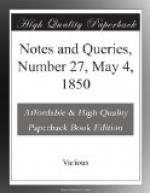Red Lion Square.—“The benevolent Jonas Hanway, the traveller, lived and died (1786) in a house in Red Lion Square, the principal rooms of which he decorated with paintings and emblematical devices, ’in a style,’ says his biographer, ‘peculiar to himself.’ ‘I found,’ he used to say, when speaking of these ornaments, ’that my countrymen and women were not au fait in the art of conversation, and that instead of recurring to their cards, when the discourse began to flag, the minutes between the time of assembling and the placing the card-tables are spent in an irksome suspense. To relieve this vacuum in social intercourse and prevent cards from engrossing the whole of my visitors’ minds, I have presented them with objects the most attractive I could imagine—and when that fails there are the cards.’ Hanway was the first man who ventured to walk the streets of London with an umbrella over his head. After carrying one near thirty years, he saw them come into general use.”
Downing Street.—“Baron Bothmar’s house was part of the forfeited property of Lee, Lord Lichfield, who retired with James II., to whom he was Master of the Horse. At the beginning of the present century there was no other official residence in the street than the house which belonged, by right of office, to the First Lord of the Treasury, but by degrees one house was bought after another: first the Foreign Office, increased afterwards by three other houses; then the Colonial Office; then the house in the north corner, which was the Judge Advocate’s, since added to the Colonial Office; then a house for the Chancellor of the Exchequer; and lastly, a whole row of lodging-houses, chiefly for Scotch and Irish members.”
Whitehall.—“King Charles I. was executed on a scaffold erected in front of the Banqueting House, towards the park. The warrant directs that he should be executed ‘in the open street before Whitehall.’ Lord Leicester tells us in his Journal, that he was ’beheaded at Whitehall Gate.’ Dugdale, in his Diary, that he was ’beheaded at the gate of Whitehall;’ and a single sheet of the time reserved in the British Museum, that ‘the King was beheaded at Whitehall Gate.’ There cannot, therefore, be a doubt that the scaffold was erected in front of the building facing the present Horse Guards. We now come to the next point which has excited some discussion. It appears from Herbert’s minute account of the King’s last moments, that ’the King was led all along the galleries and Banqueting House, and there was a passage broken through the wall, by which the king passed unto the scaffold.’ This seems particular enough, and leads, it is said, to a conclusion that the scaffold was erected on the north side. Where the passage was broken through, one thing is certain, the scaffold was erected on the west side, or, in other words, ‘in the open street,’ now called Whitehall; and that the King, as Ludlow relates in his Memoirs, ’was




